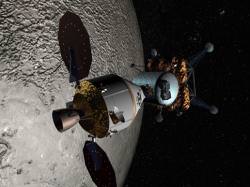There are many ways space exploration can affect our environment right here on Earth: toxic chemicals used to manufacture the rocket, carbon dioxide pumped into the atmosphere and the energy used to manufacture the equipment and vehicles, just to name a few. For the next era in space exploration, the Constellation Program, NASA has released a 500-page document detailing its effect on the environment.
Back in September 2006, NASA solicited feedback from the public about their plans for the Constellation Program. They were looking for environmental issues and concerns that the people might have. The agency released a draft of their reply to these concerns in August 2007.
The document released Wednesday, is called the Final Constellation Programmatic Environmental Statement (PEIS), and it addresses the comments made to the draft version of the document.
The document explores each NASA centre across the United States, what parts of the Constellation Program it will work on, and the environmental impact the centre might have. This part of the document is fascinating to show how the whole program will come together – where each part will be built.
• Risks to the public associated with launch and Earth atmospheric entry
• Environmental impacts of the use of solid rocket fuels on the ozone layer and impacts associated with the deposition of combustion products near the launch area
• Impacts on local animal species (e.g., sea turtles and manatees) associated with construction and launch activities in the John F. Kennedy Space Center (KSC) area
• Noise impacts associated with launch events
• The relationship between the Constellation Program and the Space Shuttle Program, including how the socioeconomic impacts of the Space Shuttle retirement and the Constellation Program overlap.
Perhaps more interesting than the things they considered where the issues that the document won’t consider. For example, the document expressly refuses to study the environmental impact on outer space itself, such as orbital debris. It also doesn’t consider any military aspects associated with the program and the environmental impact of that. (If the Constellation Program helps launch orbital space lasers, and they’re used to zap sea turtle habitats, that’s not NASA’s problem.)
Although they put in their questions, several submitters won’t get an answer. For example, the document won’t address how the Kennedy Space Center could manage its light pollution, monitor bird strikes, or raise awareness of metals in the environment. And the environmental impact on the Moon is right out of the question.
Anyway, if you’re interested in this topic… and who wouldn’t be, you can access the whole document online.
Original Source: NASA


Hm. And it doesn’t even mention that it doesn’t consider carbon dioxide emissions. I can’t help feeling there’s a lurking scandal there.
May be they want an excuse not to go to the moon……
all I want is someone to do a fly by at least so I can see the junk we left there and then I can believe that we were there!
I still can’t believe that there are people, who don’t believe that we landed on the moon. Not to tell my age but I watched the landing on a black and white TV.
It would seem a low angle freight launch on atmosphere breathing engines with a rocket unit to achieve orbit would reduce pollution for the bulk of the weight transported aloft.
Personnel carriers, such as a development on Spaceship Two, could taxi the flight crew to the ISS or other junction where they would join the vessel bound further out.
Returning to Earth might involve docking with and riding back in the same spacecraft. B. Rutan proved the lower speed re-entry concept as viable in Spaceship One. This method should avoid the danger of high speed entry of the atmosphere and the need for splash-down with the attendant risks and expenses.
I’ve done a little research on this and found that the environmental impacts are HUGE! The Constellation Program results in contributions to global warming and impacts the ozone layer. In NASA’s 500 page document they brush this fact aside by saying its only a small impact, but based on the carbon dioxide emissions and the ozone depleting substances (HCFC) used to produce the rocket motors this is not true. The impact is big. the exhaust clouds from the takeoff alone have the potential to kill all plant species and burrowing animals it comes in contact with as well as creating pollution in the water. Look it up!